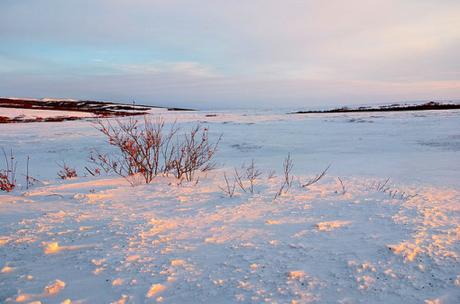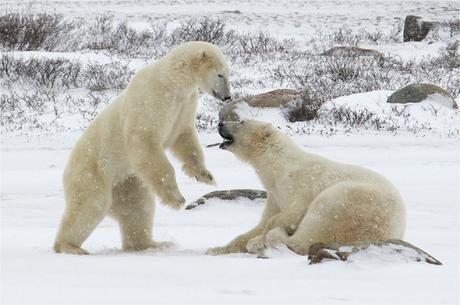The World’s Ice Deserts: The Tundra Biome
The tundra is coldest of all the biomes with an annual average temperature less than 5°C, and precipitation (mostly in the form of snow) less than 100 mm per year. The weather conditions at tundra are so harsh that only a handful of plants and animals can even survive there. The word tundra comes from a Finnish word ‘tunturia’ that means treeless plain.
The tundra is one of the least understood and most fascinating biomes on the planet. This incredibly difficult climate and environment has both a bizarre and diverse range of animals that have learned to survive with the limited amounts of green plant life, sunlight, and moisture. Due to extremely cold temperatures, the layer just below the surface remains permanently frozen. This frozen layer of ground is called ‘permafrost’.
While the tundra biome is typically through of as the “frozen tundra,” it is in fact made up of variations in temperature, climate, and amounts of precipitation, depending on where it is located. Tundra is mostly known for its frost-molded landscapes, extremely low temperatures, little precipitation, poor nutrients, and short growing seasons. Tundra is broadly separated into two types: arctic tundra and alpine tundra.

Many climate scientists say their biggest fear is that warming could melt the Arctic permafrost – which stretches for thousands of miles across Alaska, Canada, and Siberia.
– Michael Specter
Climate of the Tundra
Extreme cold temperatures define the typical climate of the tundra.
The arctic tundra, which is located in the northern hemisphere surrounding the north pole, is characterized by extremely cold and dry conditions, similar to a frozen desert. Furthermore, during the winter months, periods without daylight can extend for weeks, with extremely cold temperatures being reached. In summer months, the sun can shine almost around the clock, which is why so many plants and animals need this time for survival.
Alpine tundra, on the other hand, can be found on the tops of the world’s highest mountains. Similar to the arctic tundra, these areas are defined by freezing temperatures and dry air, though they are located in higher elevations. Because of these heights, alpine tundra is often subject to larger concentrations of sunlight at a time, because the air and atmosphere is thinner, thereby allowing rays to penetrate stronger.
Location of the Tundra
There are two main types of tundra biomes in the world, one at the Arctic Circle in the northern hemisphere, and the other that is found on the tops of the highest mountains in the world.
- The Arctic Tundra: Located in the northern hemisphere, the arctic tundra is, quite literally, the world’s north pole. It spans almost 20% of the earth’s surface, and is located at latitudes 55° to 70° N. It is extremely cold, and one of the world’s least populous areas.
- Alpine tundra is found on mountaintops that are too cold for trees to grow, particularly in the highest of elevations.
- The Antarctic region is actually significantly colder than the arctic, so it is not technically considered tundra. There, overall the yearly average temperature can be as low as -70°F (-56°C) so it is characterized by entirely different ecosystems.
Temperature of the Tundra
The tundra is by far the coldest of all the world’s biomes and is one of the world’s areas that is least inhabited by man.
Tundra areas are also categorized as windy, with typical sustained wind gusts of around 30-60 mph. This occurs both on flatter arctic tundra regions as well as on high altitude mountaintops.
- The arctic tundra has average winter temperatures of 34° C (-30° F) and average summer temperatures of 3-12° C (37-54° F). The highest parts of the arctic tundra can have winter temperature averages of −28 °C (−18 °F), sometimes dipping as low as −50 °C (−58 °F). Obviously, most living creatures in the arctic tundra have the 50 to 60 day summer period with which to concentrate growth and the search for nutrients to sustain the rest of the year, when conditions are far too harsh.
- Alpine tundra typically has a longer growing season each year – around 180 days – but temperatures in these areas typically have temperatures at night that are below freezing, and strong wind patterns often greatly affect the ability to sustain life. Temperatures are typically between -12 and 10° C (10-50° F) in the warmer months.
Precipitation of the Tundra
The extreme cold temperature of the tundra means that it does not receive a lot of precipitation, as it is literally too cold for precipitation to fall. Rainfall-wise, tundra is more similar to deserts in yearly amounts, which is why it is often referred to as the frozen desert.
However, because there is so much frozen ground and the air is so cold, plants and animals can survive on limited rainfall because the process of evaporation is nowhere near as efficient as in warmer regions.
- The arctic tundra receives approximately 15 to 25 cm (6 to 10 inches) of precipitation each year, which includes both rainfall/snowfall and melting snow and ice.
- Alpine tundra typically receives slightly higher amounts of yearly precipitation, around 30 cm (almost 12 inches).
Plants of the Tundra
The name tundra itself is derived from tunturia, the Finnish word for “treeless plain,” and tundar, the Russian word for “treeless mountain tract.” Understandably, due to the harsh climate and fairly constant frozen ground cover, plants find it hard to exist in regions of severe cold with periods of little light. However, research has shown that there are close to 1,700 different varieties of plant that call the tundra home.
Nitrogen and phosphorous take the place of plant life as a basic form of sustenance, as they are nutrients released via the process of decomposition of dead organic matter.
The soil makeup in the arctic tundra is decidedly different from that in other regions of the world. The subsoil in the tundra is a permanent layer of frozen rocks and small material, called permafrost, which typically includes about 25 to 100 cm (10 inches to 3 feet) of depth. In warmer months, melting snow will provide moisture accumulations in the soil above the permafrost, which allows for plants to grow.
One of the greatest current threats to the arctic tundra is the melting of layers of permafrost due to overall warming temperatures in the world, largely the result of pollution and greenhouse gases.
In alpine tundra, soil may be better drained, but the plant life in these areas are similar to those in the arctic tundra.
One of the amazing adaptations of plant life in the tundra biome is that no plants in the area have significant deep root systems, so as to remain in the wet topsoil. Lower plants and shrubs are much more common in the area than large trees, since they do not require deep roots and can change easier with the cold and summer seasons. Fascinatingly, similar to animals, plants can grow closer together in order to provide warmth to each other.
In order to overcome issues with the lack of pollinating insects and birds, most plants in the tundra reproduce asexually rather than by flowering and pollination.
Common plants found in the tundra biome include:
- Reindeer moss
- Crowberry
- Heath
- Liverwort
- Tussock grass
- Willow grows as a low carpet cover in some areas
- Over 400 different types of flowers
- Lichen
- Dwarf trees, including small birches

Animal of the Tundra
There are not a lot of animals in the tundra biome, but those that are there have some fascinating adaptations for survival in this harsh region. It is estimated that there are about 48 species of mammals that live in the tundra. Many mammals in tundra regions will hibernate during the harshest winter months, and most types of birds will migrate to warmer weather.
People do live in certain parts of the tundra, but that is mainly for industry-specific work such as working for oil rigs. While these settlements are typically small and far less populous than other man inhabited areas, the presence of humans can and does affect the delicate balance of the tundra ecosystem.
Native individuals who reside in tundra areas typically follow the patterns of a main source of survival; for instance, there are some tribes who exist on the entire bodies of reindeer in tundra areas.
The main types of animals that are found in the tundra are those that eat plants, those that eat animals, fish, insects, and birds.
Plant-eating animals (Herbivores)
- Voles
- Lemmings
- Squirrels
- Arctic hare
- Snowshoe rabbits
- Caribou/reindeer
- Musk oxen
- Mountain goats
Meat-eating animals (Carnivores)
- Wolves
- Wolverines
- Arctic foxes
- Polar bears
Fish
- Salmon
- Cod
- Trout
- Flatfish
Insects
- Mosquitoes
- Flies
- Grasshoppers
- Moths
- Arctic bumble bees
- Beetles
Birds
- Falcons
- Ravens
- Loons
- Sandpipers
- Terns
- Gulls
- Snow buntings
- Harlequin duck

